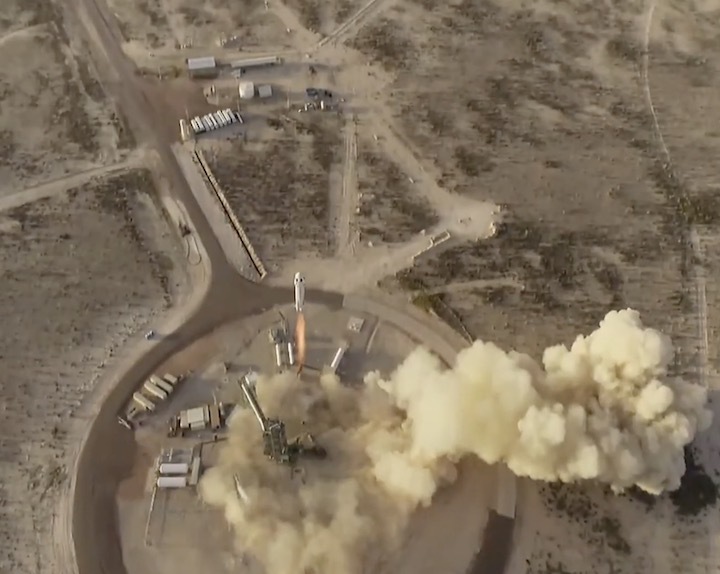20.10.2020

VAN HORN, TEXAS – Space Environment Technologies (SET), an international space weather research and operations company, successfully executed the second suborbital mission reaching space of its ARMAS FM7 instrument on Blue Origin’s New Shepard space capsule. The New Shepard NS-13 flight for the Automated Radiation Measurements for Aerospace Safety (ARMAS) program accurately measured the radiation environment deriving from Galactic Cosmic Rays. This flight, in addition, passed an important technological milestone by transmitting, in real-time, a Bluetooth-enabled automated data feed from the ARMAS FM7 instrument to an iPhone iOS app onboard the capsule. This was an important milestone for modernizing International Space Station and Lunar Gateway radiation automated data communications with Internet of Things (IOT) technology.
The ARMAS Suborbital mission launched from Blue Origin’s West Texas Launch Site (WTLS) at approximately 8:36 a.m. CDT on Tuesday, October 13, 2020, reaching an altitude of approximately 107 km with a flight duration of 10 minutes, 9 seconds.
The ARMAS program has developed real-time monitoring technology to manage radiation risks for crew and passengers on commercial aviation and commercial space transportation. The ARMAS Suborbital mission, managed by SET and partially funded through NASA’s Flight Opportunities program (FOP) and Small Business Innovative Research (SBIR) offices, was developed by a team led by Principal Investigator Dr. W. Kent Tobiska of SET. ARMAS uses an innovative approach with dosimeter sensors linked to ground-based servers and physics-based models that aid space radiation research and improve aviation and space-flight safetyby providing global radiation weather.
“The Blue Origin New Shepard flight hosting ARMAS takes this program to the next milestone – implementing the system in multiple air and space vehicles for accurate, automated radiation monitoring,” said Dr. W. Kent Tobiska, Principal Investigator for ARMAS.SET Senior Radiation Scientist Dr. Brad “Buddy” Gersey of SET noted that “This flight nowgives us confidence for conducting accurate, calibrated operational management of radiation hazards from the Earth’s surface to the top of the atmosphere.”
During flight, ARMAS dose data are retrieved in real-time using Iridium satellites or Bluetooth, depending upon the vehicle. Data are downlinked to the ground and then assimilated by NASA’s Nowcast of Atmospheric Ionizing Radiation for Aviation Safety (NAIRAS) physics-based model of the global radiation environment. As ARMAS data are ingested into the model, the accuracy of radiation dose rates along air and space flight paths improves. ARMAS then improves air and space traffic management by monitoring global radiation “weather” and allowing commercial air and space traffic to avoid higher radiation areas. The ARMAS iOS app in the Apple app store, available in late October 2020, provides much of this information to individual users.
An ultimate objective of this program is to reduce crew and passenger radiation exposure by providing the information to flight service operators so they can fly in lower radiation regions or spend less time in higher radiation locations. Accurate real-time monitoring of the dynamically changing radiation from galactic cosmic rays, solar flares, or the Van Allen radiation belts is an example where space weather services can help manage an environment that affects the health and productivity of a technologically advancing society.
About Space Environment Technologies.
Space Environment Technologies’ (SET) Space Weather Division (SWD) is headquartered in Southern California and conducts fundamental space research. It provides advanced space weather products and services to U.S. Government and commercial aerospace customers. These customers include U.S. Government agencies such as NASA, NOAA, USAF, NSF. In addition, SET provides services to international government and commercial aerospace organizations. SET SWD transitions research models into operations, such as the JB2008 thermospheric density model, the USGS Dst index, the ARMAS aircraft radiation measurement system, and the AWSOME total dose and SEU system for avionics’ radiation hazard management in Low Earth Orbit vehicles. SET SWD is particularly active with
- the NASA Nowcast of Atmospheric Ionizing Radiation for Aviation Safety (NAIRAS) global radiation model development in 2009-2011 that SET has been operationally supported at NASA Langley Research Center since 2012;
- the NASA Phases I, II, IIE, III Automated Radiation Measurements for Aerospace Safety (ARMAS) SBIR (2011-2019) that builds radiation detection instruments and ground system to monitor real-time aircraft radiation dose rates;
- the MDA Phases I, II, IIE Advanced Weather Simulation and Operational Modeling Effort (AWSOME) SBIR project (2014-2018) that built a server-based, real-time, operational space weather radiation environment coupled with operational CREME96 model routines that produce spectra for linear energy transfer (LET) of high Z (HZE) particles, protons, and electrons for any user-supplied parts lists; and
- the NASA RADIation environment using ARMAS data in the NAIRAS model (RADIAN) Cooperative Agreement enabling SET to provide ARMAS data for assimilation into the NASA NAIRAS global radiation model; this allows the specification of the radiation environment from the surface to Low Earth Orbit.
ARMAS Payload on the P10 flight

Blue Origin Booster landing for the P10 flight

New Shepard Capsule landing for the P10 flight

SET ARMAS Launch Team for the P10 flight

Quelle: Space Environment Technologies
